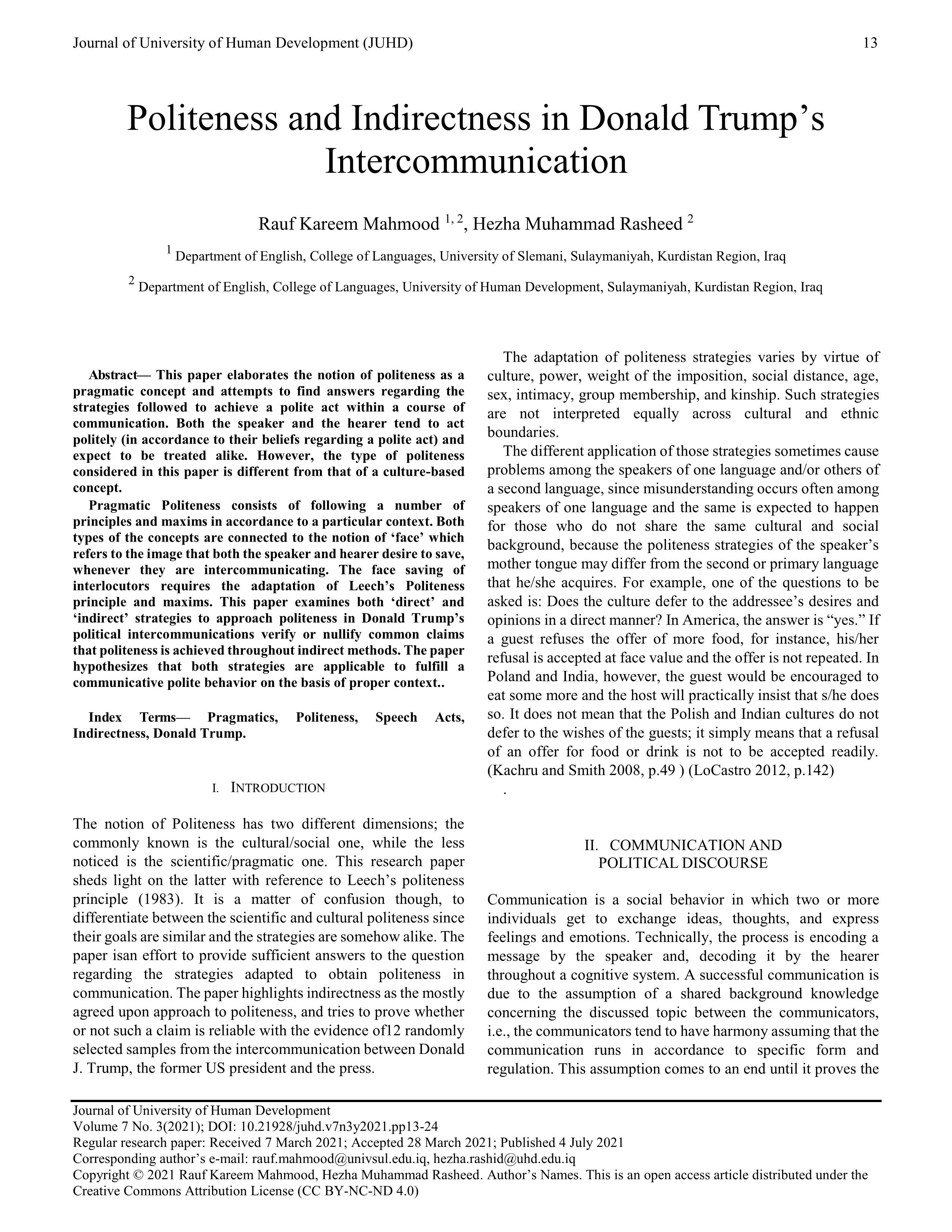Politeness and Indirectness in Donald Trump’s Intercommunication
DOI:
https://doi.org/10.21928/juhd.v7n3y2021.pp13-24Keywords:
Pragmatics, Politeness, Speech Act, Indirectness, Donald TrumpAbstract
This paper elaborates the notion of politeness as a pragmatic concept and attempts to find answers regarding the strategies followed to achieve a polite act within a course of communication. Both the speaker and the hearer tend to act politely (in accordance to their beliefs regarding a polite act) and expect to be treated alike. However, the type of politeness considered in this paper is different from that of a culture-based concept.
Pragmatic Politeness consists of following a number of principles and maxims in accordance to a particular context. Both types of the concepts are connected to the notion of ‘face’ which refers to the image that both the speaker and hearer desire to save, whenever they are intercommunicating. The face saving of interlocutors requires the adaptation of Leech’s Politeness principle and maxims. This paper examines both ‘direct’ and ‘indirect’ strategies to approach politeness in Donald Trump’s political intercommunications verify or nullify common claims that politeness is achieved throughout indirect methods. The paper hypothesizes that both strategies are applicable to fulfill a communicative polite behavior on the basis of proper context.
References
2. Black, E. (2006). Pragmatic stylistics. Edinburg university Press: Edinburg
3. Bonvillian, N. (1993). Language, culture, and communication. Prentice-Hall, Inc. New Jersey. USA
4. Chapmann, S. (2011). Pragmatics. Palgrave Macmillan.
5. Crystal, D. (2003). A dictionary of Linguistics & Phonetics. 5th ed. Blackwell publishing.
6. Down, A., Wichmann, A. (2012). Pragmatics: An advanced resource book for students. Routledge.
7. Gingrich (2017). NEWT GINGRICH, Understanding Trump. Center Street. New York.
8. Herk, G. (2012). What is Sociolinguistics?. Willey Blackwell.
9. Holmes, J. (2013). An introduction to Sociolinguistics. 4th ed. Pearson.
10. Kachru, Y. and Smith, L. (2008).1st ed. Routledge.
11. Leech, J. (1983). Principles of Pragmatics. Longman. New York.
12. Levinson, Stephen C. (1983). Pragmatics. Cambridge University Press.
13. LoCastro, V. (2012). Pragmatics for language educators. Routledge.
14. Saeed, J. (2009). Semantics.3rd ed. Wiley-Blackwell.
15. Taguchi, N. (2019). The Routledge Handbook of Second Language Accuisition and Pragmatics. Routledge.
16. Thomas, J. (1995). Meaning in interaction: an introduction to Pragmatics. Routledge.
17.
18. Trump, D. J. [@realdonaldtrump]. (2020, October, 10). [Tweet]. Tweeter.
https://twitter.com/realdonaldtrump/status/1310036242470514689?s=21
19. Trump, D. J. [@realdonaldtrump]. (2020, April, 27). [Tweet]. Tweeter. https://twitter.com/realdonaldtrump/status/1310036242470514689?s=21
20. Trump, D. J. [@realdonaldtrump]. (2020, December, 12). [Tweet]. Tweeter. https://twitter.com/realdonaldtrump/status/1337586206683574272?s=21
21. (2017, February, 17). Full transcript: President Donald Trump's news conference. CNN Politics. https://edition.cnn.com/2017/02/16/politics/donald-trump-news-conference-transcript/index.html
22. Trump D. J. [@realdonaldtrump]. (2020, December 24). [Tweeter]. Tweeter. https://twitter.com/realdonaldtrump/status/1310036242470514689?s=21
23. Trump D. J. [@realdonaldtrump]. (2021, January,17). [Tweeter]. Tweeter. https://twitter.com/realdonaldtrump/status/1310036242470514689?s=21
24. Vanity Fair. (2016, October 10). Hillary Clinton and Donald Trump Say Something Nice About Each Other. https://www.vanityfair.com/video/watch/hillary-clinton-and-donald-trump-say-something-nice-about-each-other
25. Vrchueren, J. (2003). Understanding Pragmatics. Arnold. Great Britain.
26. White House. (n. d.). Retrieved from. https://www.whitehouse.gov/people/donald-j-trump/
27. White House. (n. d.). Retrieved from: https://www.whitehouse.gov/briefings-statements/remarks-president-trump-president-niinisto-republic-finland-joint-press-conference/ (accessed: September 2020).
28. Yule, G. (1996). Pragmatics. Oxford University Press.
29. (2020, April 27). Trump berates female reporter when questioned over Covid-19 response. [Video]. YouTube. https://www.dailymotion.com/video/x7tmyls
30. (2018, November 7). ‘You are a rude, terrible person’: Trump attacks CNN reporter. [Video]. YouTube. https://www.youtube.com/watch?v=v3abZ4aAGUU
31. (2016, May 31). Donald Trump attacks the press. [Video]. YouTube. https://www.youtube.com/watch?v=Y2vozC_kP6Q (accessed: December 2020)
32. (2016, October 10). Hillary Clinton and Donald Trump Say Something Nice About Each Other. [Video]. YouTube. https://www.vanityfair.com/video/watch/hillary-clinton-and-donald-trump-say-something-nice-about-each-other
33. (2017, January 11). Donald Trump shuts down CNN reporter-BBC News. [Video]. YouTube. https://www.youtube.com/watch?v=W6ZHY0E4_Wg



